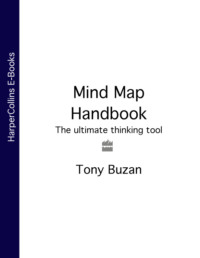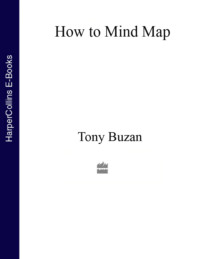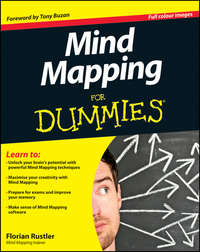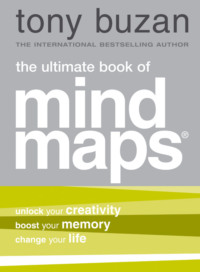
Полная версия
The Power of Creative Intelligence: 10 ways to tap into your creative genius
Albert Einstein was nominated as the greatest creative genius of the 20th century. However, he was a poor student, preferring daydreaming to studying, and was eventually expelled from school for being a ‘disruptive influence’.
As a teenager he became inspired by the imaginative side of mathematics and physics, and was equally interested by the work of Michelangelo, whom he studied in depth. These mutual interests encouraged him to play even further with his imagination, and he developed his now-famous ‘Creative Mind Games’ in which he posed himself an intriguing question, and then allowed his imagination to run riot.
In one of his most famous Creative Mind Games, Einstein imagined that he was on the surface of the sun, grabbing a sunbeam, and travelling directly away from the sun at the speed of light, to the very ends of the universe.
When he came to the ‘end’ of his journey, he noticed to his astonishment that he was roughly back where he had started. This was logically impossible: you don’t go in a straight line forever and end up where you started!
Einstein therefore took another imaginary sunbeam ride from another part of the sun’s surface, and again went on a straight-line journey to the end of the universe. Once again he ended up relatively near where he had started.
Slowly the truth dawned on him: his imagination had told him more truths than his logic. If you travel in straight lines ‘forever’ and continually return to the vicinity of where you started, then ‘forever’ must be at least two things: curved in some way, and possessing a boundary.
This was how Einstein came to one of his most profound insights: our universe is a curved and finite universe. He did not come to this giant creative realization by left-brain thinking alone, but by combining his knowledge of number, word, order, logic and analysis with his massive imagination, spatial awareness and ability to see the whole picture.
His insight was a perfect blending and conversation between both sides of his brain. It was a perfect ‘whole-brained’ creative realization.
The same turned out to be true, in reverse, for the ‘right-brained’ creative geniuses. Let us take, for example, the ‘ultimate’ right-brainer, Ludwig van Beethoven.
Case History – Ludwig van Beethoven
Beethoven is known for his turbulent, questioning and passionate spirit, for his desire for freedom from tyranny and censorship and for his ongoing fight for freedom of artistic expression. He is generally accepted as the ‘perfect’ example of the wild and untamed model of genius.
All of this is true, and fits in with the traditional interpretation of the right-brained creative genius. However, what has escaped most people’s attention is that Beethoven, like all other musicians, was also incredibly left-brained!
Consider the nature of music: it is written on lines, in sequence; it follows its own logic; and it is based on numbers. Music has often been described as the most pure form of mathematics there is (and it is interesting to note that many of the great mathematicians had music as their main hobby, and vice-versa).
As well as being passionately imaginative and rhythmical, Beethoven was also passionately meticulous. It was Beethoven who pioneered the use of the musical metronome, stating that it was a Godsend to him because it would now mean that every musician and conductor in the future would be able to play his music at precisely the right rhythm, with precisely the right emphasis, and at exactly the right mathematical tempo!
As with Einstein, Beethoven was neither right-brained or left-brained. He was completely and creatively whole-brained.
My research into the great creative geniuses confirmed that they all used the ‘whole brain’ – the full range of their cortical skills, where each skill supplemented and supported the others.
These findings shed light on the second big problem with the research and its assumptions.
problem number 2
The second problem was a major one. The left brain ‘intellectual’ activities tended to be labelled ‘male’ activities, and right brain ‘creative’, and ‘emotional’ activities came to be seen as ‘female’ activities. This was comprehensively and dangerously wrong!
These labels simply extended and ‘confirmed’ the centuries-old beliefs that:
academics, education and intellectuality involved only words, number and logic and not imagination, colour and rhythm
business was a place for strict order only
men were logical, rational individuals with no emotion, imagination or ‘colour’
women were irrational daydreamers
emotion was not based on associative logic
creativity and art were not ‘proper’ pursuits, and had no rationality or science behind them.
The tragedy of these misconceptions, which sadly are still common today and which The Power of Creative Intelligence will help to dispel, is that they blind the mind to the truth, and therefore diminish pleasure, experience and existence.
Unfortunately these misconceptions are especially prevalent in the arena of education. Because we assume that education has to be ‘left-brained’, we label those children who are energetic, imaginative, colourful, curious or given to excessive bouts of daydreaming as naughty, disruptive, hyperactive, slow or backward. We should instead be labelling them as potential creative geniuses just beginning to explore the range of their abilities!
Similarly many businesses have become stuck in the ‘left-brained’ rut, and as a result are destroying not only the synergy that comes from combining left-brain business practices with imagination and flair, but also their reputations and their bottom lines.
Consider also, in the context of this book, the global image of the artist. Surveys have shown that most people consider artists to be messy, untidy, dishevelled, weak in logic and memory, and lacking in structural and organizational skills.
Sadly millions of art students around the world try to live ‘up’ (it’s actually down!) to this ‘ideal’ vision of the artist. As a result they reject words, number, logic, order and structure, and create only passing images in their minds.
left/right brain thinking in the 21st century
As the Century of the Brain begins, we now realize that the creative brain is the whole brain. Furthermore, we realize that our earlier acknowledgement of our labelling mistakes has led us to an awareness that our creative potential is even greater than we had thought.
A simple question and comparison will make this clear.
If we have been using only half of the skills of the brain, at what percentage efficiency have we been operating?
The immediate answer would appear to be 50 per cent. This indicates that we have been making ourselves into half-wits! However, even this is an overestimation, as a simple example makes clear.
If I said to you that I wanted to measure your efficiency at running, and in Trial 1 I allowed you to use 100 per cent of your body, including arms and legs. Imagine how you would do if I videoed your running style and then examined it for mechanical efficiency. Most of us would score pretty highly.
Imagine now that in Trial 2 I allowed you only 50 per cent of your operating potential, and tied your right hand and foot together, behind your back. How would you do? You’d be flat on your face within a couple of seconds! Efficiency? Less than zero.
Why? Because the parts of your body are made to work together, and in so doing each part multiplies a thousand-fold the efficiency of the other.
It is the same with your brain. When you use only one side of your cortical skills, your creativity is nothing in comparison to what it can be. When you use both sides, your creative potential becomes infinite.
In the Creativity Workout that follows, and in the remaining chapters, I will explore methods of unleashing that infinite creative potential.
creativity workout
1. Use the Whole-brain Skills Set to Examine your Life
Check how many of your left-brain skills you normally use and nurture. Next do the same with your right-brain skills. Pay attention to any of those right or left-brain areas that you are neglecting and begin to exercise and strengthen them right away.
2. Education
If you have children, apply whole-brain thinking to their entire education, including school, social and home-life education. Try to help your children achieve a balanced education, in order that they may lead far more creative and fulfilled lives.
Not only that – apply the same principles to your own ongoing, life-long learning, so that you may lead a more creative and fulfilled life too.
3. Take Breaks
Surprisingly, whole-brain thinking demands that if you are going to be fully and truly creative, you must take regular breaks.
Think about it: where are you when you come up with those bursts of imagination, those solutions to problems, those great fantasies and daydreams? Most people’s answers include some or all of the following:
in the bath
in the shower
walking in the country
before going to sleep
while asleep
upon waking up
while listening to music
on a long-distance drive
while out running
while swimming
lying on the beach
when ‘idly’ doodling
In what state are your body and mind at such times? Relaxed, and often alone.
It is in these rest-periods that the two sides of your brain are able to converse and communicate with each other, and when the vast wellspring of your creativity is allowed to express itself.
If you don’t decide consciously to take these breaks, your brain will decide for you. Many ‘hard working’ (but not ‘smart working’) people report that, as the years go on, they become more stressed and their concentration begins to wander. This is actually a good thing, for it is their right brains insisting that a little bit of imagination and fantasy should be allowed in to balance an unbalanced state.
If you are in this situation and you continue to persist in pushing your left-brain-dominant lifestyle, your brain will make you take other kinds of breaks, ranging from losses of concentration, to mini-breakdowns in which you become unreasonably irascible, to full blown blow-outs where the only cure is … rest and relaxation!
Do it consciously. Give your brain and yourself a break. Your Creative Intelligence will love you for it.
4. Go for Long Walks or Rambles
The Romans had a special phrase, solvitas perambulum, which can be roughly translated as ‘solve it while you walk’. What they had realized, although obviously not in left/right-brain terms, was that if you take your brain for a walk, especially outside in the country, the steady rhythm of your limbs’ movement, the regular rhythm of your heart pumping more strongly, doses of oxygen-filled blood flowing into your brain, and the feast that your eyes, ears and other senses have while you walk, all contribute to creative thinking and problem solving.
If you have a creative task or problem upon which you are working, ‘Walk it Out’ and you’ll ‘Work it Out’!
5. Be Creative in your Everyday Life
Using a pen and paper, list those areas in your everyday life that you think are creative, and those that you think are not creative. When you have finished, read on.
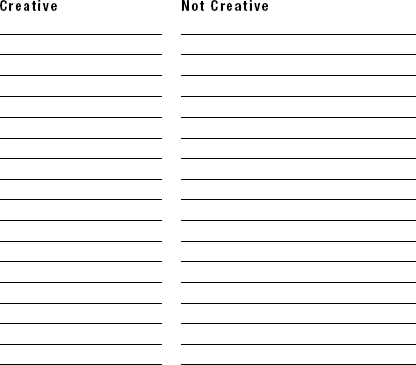
The ideal answer to the above exercise is that all aspects of your daily life are intrinsically creative, and that all of them can be enhanced by applying more of the full range of your left and right-brain skills. Consider the following everyday activities; they are all dependent upon Creativity:
cooking
decorating
D.I.Y. and home improvements
photography
gardening
route finding and map reading
carpentry
flower arranging
budgeting for special events/expenses
relationships
gift wrapping
letter and message writing
setting a table
arranging house plants
looking after and training pets
planning holidays and special events
planning meetings
playing football, or any other sport
Each one of these activities can be made more interesting and creative by adding the ‘spices’ of the left and right-brain skills.
In this creative arena, little things can mean a lot. Gathering shells and driftwood from a beach and displaying them in your home, or using it for wood-turning; making patchwork quilts from a multitude of scraps of otherwise useless material; decorating your dinner table by putting a flower on each person’s plate and using shells from the beach from which to serve your salt and pepper; or finding new and different routes to get to work each week, are all things that take little effort, and which add immeasurably to the creative feel of your life.
Holiday times and seasonal celebrations especially, are wonderful opportunities for displaying your Creative Intelligence. Make it a Creative Feast with decorations, visual beauty and visual humour. Create your own cards and gifts to give to people, or plan a dinner party for your friends – the possibilities are endless!
6. Your Mastermind Group
All the great creative geniuses had heroes or heroines to whom they looked for inspiration. Alexander the Great had his tutor Aristotle; Julius Caesar had Alexander the Great; all the great geniuses of the Italian Renaissance had the examples of Classical antiquity; the Russian Empress Catherine the Great looked to Peter the Great for inspiration; Mohammed Ali had Sugar Ray Robinson; Isaac Newton had Socrates; Stephen Hawking had Isaac Newton, and so on, throughout the pantheon of genius.
The technique the creative greats used was to hold imaginary conversations with their heroes, asking them for ‘thoughts’ and inspiration. This Creative Thinking technique can be used for pursuing mighty scientific and cultural goals, and it can also be used by everyone in their normal daily lives.
I have personally found this technique exceptionally valuable in my life, and have used it successfully for over 20 years. It has allowed me to be especially creative whenever I have encountered any major opportunity or problem. The way I use this technique is as follows: when confronted with a situation which requires help from my Mastermind Group of heroes and heroines, I select the ones who are most appropriate for the given situation and I then imagine what advice each would give me in order to take greatest advantage of the situation. I select my heroes and heroines for their unique creative approaches, for their energy and for their astonishing success, knowing that all of this will ‘feed in’ to me and my own Creative Thinking processes.
Members of my Mastermind Group on whom I regularly call for help are:
Our Creativity guide Leonardo da Vinci, for his boundless Creativity and inventiveness.
Queen Elizabeth I, for her ability to overcome astonishing odds, to be very flexible while at the same time being steadfast, and to learn with incredible rapidity.
Buddha, for his deep exploration of the self, and for his ability to withstand the utmost suffering and deprivation.
Mohammed Ali, for his astonishing originality and creativity, combined with his representation and defence of a minority group.
Morihei Ueshiba, the founder of the Japanese martial art of Aikido. In this art, the Aikido student is taught to turn any violence into tranquillity, while simultaneously remaining steadfast.
Конец ознакомительного фрагмента.
Текст предоставлен ООО «ЛитРес».
Прочитайте эту книгу целиком, купив полную легальную версию на ЛитРес.
Безопасно оплатить книгу можно банковской картой Visa, MasterCard, Maestro, со счета мобильного телефона, с платежного терминала, в салоне МТС или Связной, через PayPal, WebMoney, Яндекс.Деньги, QIWI Кошелек, бонусными картами или другим удобным Вам способом.





